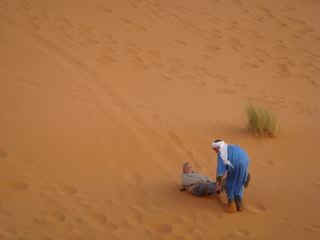|
|
||
| Day
07 Nov. 16, 2008 Rissani, Merzuga |
Submitted by Judy Wood judywood@vzavenue.net and Dick Wood richardjwood@mac.com |
|
|
Our day began on the bus with Haj as the hunter of flies When one fly was found, another was around to take its place - a never ending job for Haj.
A highlight of our day was a visit to "Maison
Touareg |
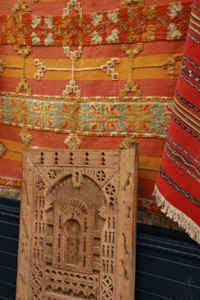 We
saw many beautiful pieces at Maison Touareg: necklaces, brooches, hands
of Fatma, keys for keeping scarves in place, many rugs, and several
pieces of clothing and brass cooking implements. Berber rugs of the 17th
century were often
light brown, orange, and blue depicting water and valleys. The landscape
rugs used green for oases, yellow for dunes, and blue for sky. A long,
red rug means "we welcome you." Touaregs are often called blue
men because of the color of their clothing, as blue as the sky. We
saw many beautiful pieces at Maison Touareg: necklaces, brooches, hands
of Fatma, keys for keeping scarves in place, many rugs, and several
pieces of clothing and brass cooking implements. Berber rugs of the 17th
century were often
light brown, orange, and blue depicting water and valleys. The landscape
rugs used green for oases, yellow for dunes, and blue for sky. A long,
red rug means "we welcome you." Touaregs are often called blue
men because of the color of their clothing, as blue as the sky. The picture by Carol Ries They like blue because it is a cooler color and it equals prosperity. After shopping time, we were invited to hear the drummers beat their drums outside in the brown tent. Of course, after the drumming, a white rug was put down and more pieces of jewelry were laid out for our perusal and purchase. A kebab lunch followed at a very nice restaurant where one of our group "stole" J's sunglasses. The "theft" was solved when the perpetrator realized she had two pair - one in her handbag and one on her head. We returned for a second night to our very nice hotel, Kasba
Tomboctou, which is situated at the foot of the sand dunes and is near
the tiny town of Hassi Labied, 5 km north of Merzouga. Before taking the
camels into the Sahara to view the changing colors of the sand as the
sun set, Meli warned us to not wear hats unless they fit very Zee was the fastest to arrive back for the return trip on camelback (photo 5). Contrary to popular opinion, these camels were neither mean nor smelly. Is it because they are well taken care of? Following our bumpy but pleasant camel ride some of our group enjoyed the pleasures of the Hamam and dinner before retiring for the night. |
|
|
Next Page Day 08
Morocco Tour itinerary
|
||
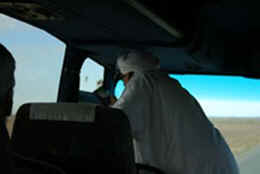
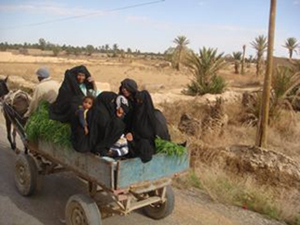 along
the roads. The residents were very happy to have had the two weeks of
rain before we arrived. Often they don't see rain for five to seven
years. Along the way, we glimpsed a donkey taxi
along
the roads. The residents were very happy to have had the two weeks of
rain before we arrived. Often they don't see rain for five to seven
years. Along the way, we glimpsed a donkey taxi 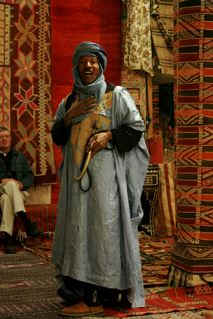 a very good shop of Moroccan crafts that displayed the contributions of
the desert nomads, the Touareg. We learned that before borders were
drawn between countries, huge caravans composed of whole tribes moved
together across the Sahara trading. They always moved in the cool of the
night when it was easier to find the right direction. One caravan could
be composed of 4,000-5,000 camels. The entire tribe moved together,
because if they got lost, they would never get reconnected. Their
language, Tashelhit (?) (also the name of the tribe of our host) was
originally written in hieroglyphics, so it could be read whether written
vertically or horizontally, backwards or forwards. The Touareg may have
some Viking ancestry, as well as Berber. They were matrilineal and
matrilocal in social structure. Before a marriage was official, the man
lived with the bride's family for a trial year (a modern echo of the
tribal structure described in the account of Abraham in the book of
Genesis). If it didn't work out, they continued to live as brother and
sister. Since the Sahara has metal, coal, silver, gold, and copper, the
Touaregs had much to work with when fashioning jewelry.
a very good shop of Moroccan crafts that displayed the contributions of
the desert nomads, the Touareg. We learned that before borders were
drawn between countries, huge caravans composed of whole tribes moved
together across the Sahara trading. They always moved in the cool of the
night when it was easier to find the right direction. One caravan could
be composed of 4,000-5,000 camels. The entire tribe moved together,
because if they got lost, they would never get reconnected. Their
language, Tashelhit (?) (also the name of the tribe of our host) was
originally written in hieroglyphics, so it could be read whether written
vertically or horizontally, backwards or forwards. The Touareg may have
some Viking ancestry, as well as Berber. They were matrilineal and
matrilocal in social structure. Before a marriage was official, the man
lived with the bride's family for a trial year (a modern echo of the
tribal structure described in the account of Abraham in the book of
Genesis). If it didn't work out, they continued to live as brother and
sister. Since the Sahara has metal, coal, silver, gold, and copper, the
Touaregs had much to work with when fashioning jewelry.
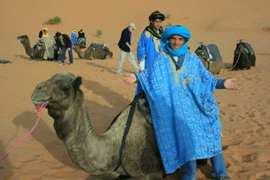 well.
Apparently camels can become very agitated if hats fly off into their
faces or if anything else unusual happens. Our camels were handled by
Ahmed who took very good care of us and pulled out a blanket that
was soon covered with items "to help my family". Several of
our group hiked to the top of a sand dune to view the sea of sand.
well.
Apparently camels can become very agitated if hats fly off into their
faces or if anything else unusual happens. Our camels were handled by
Ahmed who took very good care of us and pulled out a blanket that
was soon covered with items "to help my family". Several of
our group hiked to the top of a sand dune to view the sea of sand.